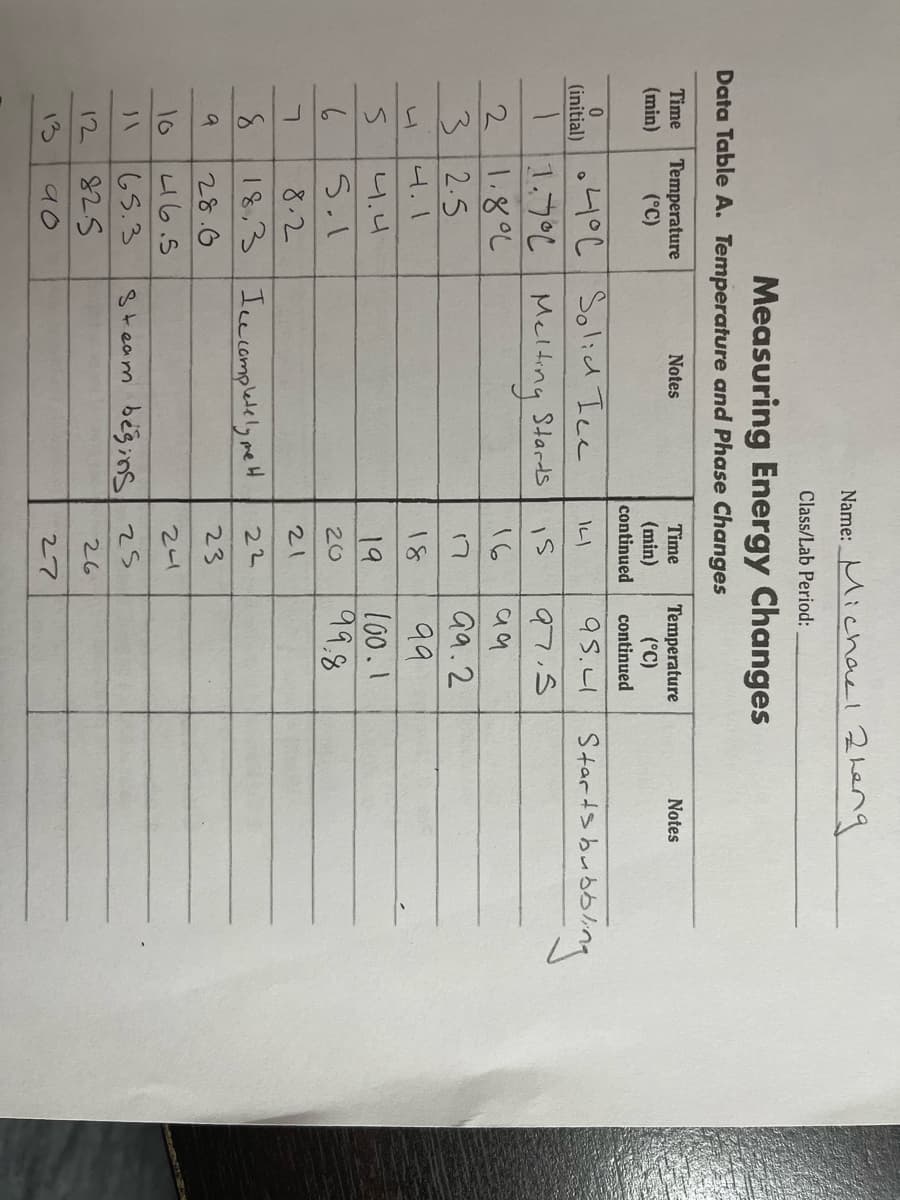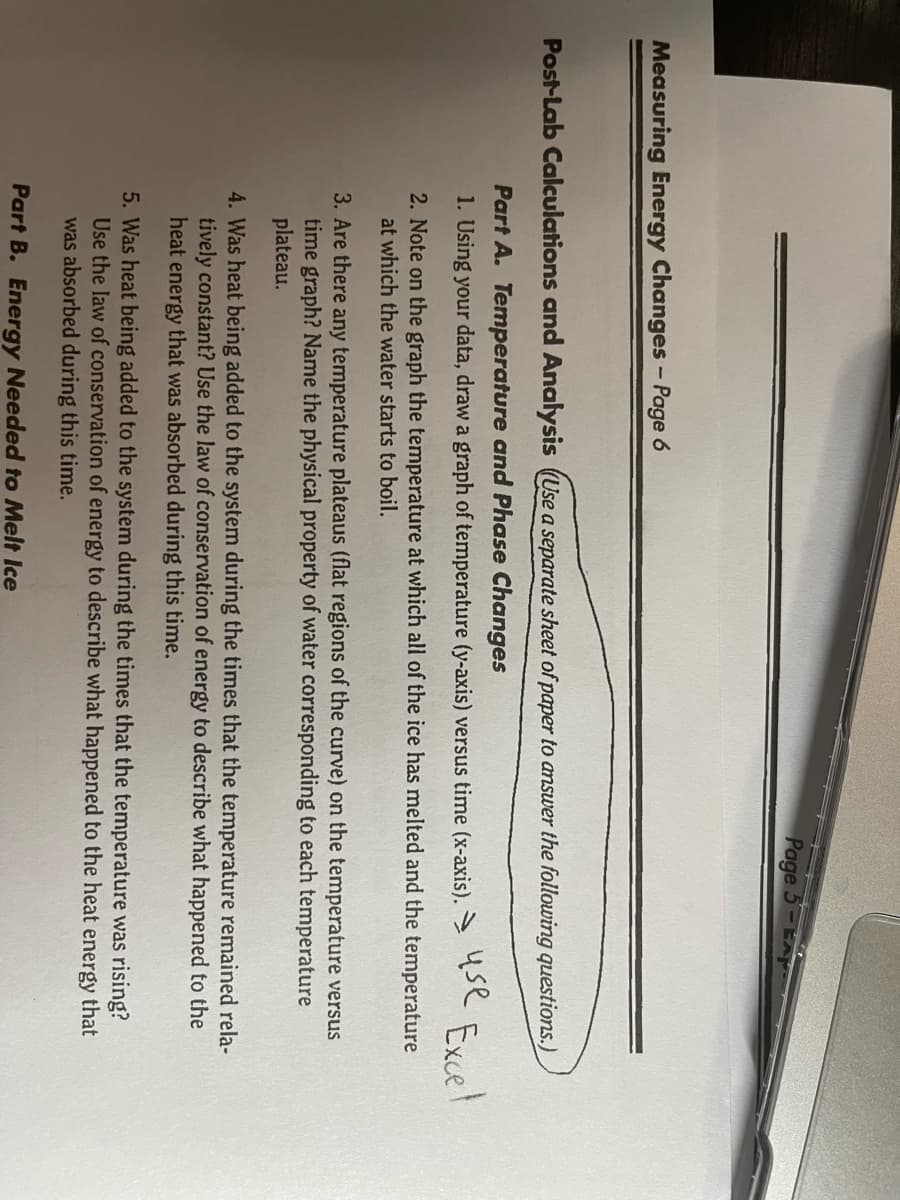3. Are there any temperature plateaus (flat regions of the curve) on the temperature versus time graph? Name the physical property of water corresponding to each temperature plateau.
3. Are there any temperature plateaus (flat regions of the curve) on the temperature versus time graph? Name the physical property of water corresponding to each temperature plateau.
Biology 2e
2nd Edition
ISBN:9781947172517
Author:Matthew Douglas, Jung Choi, Mary Ann Clark
Publisher:Matthew Douglas, Jung Choi, Mary Ann Clark
Chapter33: The Animal Body: Basic Form And Function
Section: Chapter Questions
Problem 26RQ: The body’s thermostat is located in the ___________ . homeostatic receptor hypothalamus medulla...
Related questions
Question
Answer questions 2-3

Transcribed Image Text:Name: Michae1 Zheng
Class/Lab Period:
Measuring Energy Changes
Data Table A. Temperature and Phase Changes
Time
Temperature
(°C)
Notes
Time
Temperature
(°C)
continued
Notes
(min)
(min)
continued
.4°C Solid Ice
1.7°C Melting Stards
|. ४°८
32.5
bubbling
95.1
Starts bub
(initial)
is
97.5
16
aa.2
4.1
18
99
니.니
19
100.1
20
8.2
21
8.
18,3 Ice complelely me H
22
28.6
23
10
u6.5
24
65.3
Steam begins 2s
12
26
13
90
27

Transcribed Image Text:Page 5-EA
Measuring Energy Changes- Page 6
Post-Lab Calculations and Analysis (Use a separate sheet of paper to ansuwer the following questions.)
Part A. Temperature and Phase Changes
1. Using your data, draw a graph of temperature (y-axis) versus time (x-axis). q
Excel
2. Note on the graph the temperature at which all of the ice has melted and the temperature
at which the water starts to boil.
3. Are there any temperature plateaus (flat regions of the curve) on the temperature versus
time graph? Name the physical property of water corresponding to each temperature
plateau.
4. Was heat being added to the system during the times that the temperature remained rela-
tively constant? Use the law of conservation of energy to describe what happened to the
heat energy that was absorbed during this time.
5. Was heat being added to the system during the times that the temperature was rising?
Use the law of conservation of energy to describe what happened to the heat energy that
was absorbed during this time.
Part B. Energy Needed to Melt Ice
Expert Solution
This question has been solved!
Explore an expertly crafted, step-by-step solution for a thorough understanding of key concepts.
This is a popular solution!
Trending now
This is a popular solution!
Step by step
Solved in 2 steps

Recommended textbooks for you

Biology 2e
Biology
ISBN:
9781947172517
Author:
Matthew Douglas, Jung Choi, Mary Ann Clark
Publisher:
OpenStax

Anatomy & Physiology
Biology
ISBN:
9781938168130
Author:
Kelly A. Young, James A. Wise, Peter DeSaix, Dean H. Kruse, Brandon Poe, Eddie Johnson, Jody E. Johnson, Oksana Korol, J. Gordon Betts, Mark Womble
Publisher:
OpenStax College

Human Physiology: From Cells to Systems (MindTap …
Biology
ISBN:
9781285866932
Author:
Lauralee Sherwood
Publisher:
Cengage Learning

Biology 2e
Biology
ISBN:
9781947172517
Author:
Matthew Douglas, Jung Choi, Mary Ann Clark
Publisher:
OpenStax

Anatomy & Physiology
Biology
ISBN:
9781938168130
Author:
Kelly A. Young, James A. Wise, Peter DeSaix, Dean H. Kruse, Brandon Poe, Eddie Johnson, Jody E. Johnson, Oksana Korol, J. Gordon Betts, Mark Womble
Publisher:
OpenStax College

Human Physiology: From Cells to Systems (MindTap …
Biology
ISBN:
9781285866932
Author:
Lauralee Sherwood
Publisher:
Cengage Learning